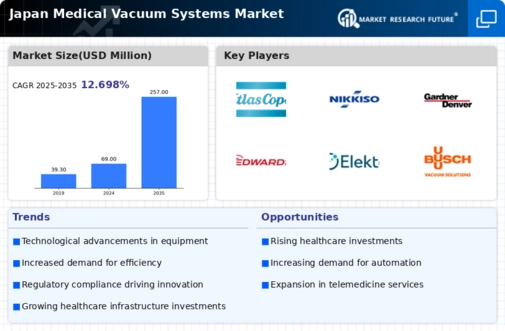Rising Healthcare Expenditure
The medical vacuum-systems market in Japan is experiencing growth driven by increasing healthcare expenditure. The Japanese government has been investing heavily in healthcare infrastructure, with spending projected to reach approximately 10% of GDP by 2025. This investment is likely to enhance the capabilities of hospitals and clinics, leading to a higher demand for advanced medical equipment, including vacuum systems. As healthcare facilities upgrade their technologies to improve patient outcomes, the need for efficient and reliable medical vacuum systems becomes paramount. Furthermore, the aging population in Japan necessitates more sophisticated medical interventions, further propelling the market. The medical vacuum-systems market is thus positioned to benefit from this upward trend in healthcare spending, as facilities seek to adopt state-of-the-art solutions to meet the growing demands of an aging demographic.
Growing Demand for Surgical Procedures
The medical vacuum-systems market in Japan is significantly influenced by the increasing demand for surgical procedures. As the population ages, there is a corresponding rise in the prevalence of chronic diseases, necessitating more surgical interventions. Reports indicate that surgical procedures in Japan are expected to grow by approximately 5% annually, creating a substantial need for reliable medical vacuum systems in operating rooms. These systems are essential for maintaining a sterile environment and ensuring the safety of surgical operations. Consequently, the medical vacuum-systems market is likely to expand as hospitals and surgical centers invest in high-quality vacuum systems to support the growing volume of surgical cases, thereby enhancing patient care.
Regulatory Support for Advanced Medical Equipment
In Japan, the medical vacuum-systems market is bolstered by robust regulatory support aimed at enhancing healthcare quality. The Pharmaceuticals and Medical Devices Agency (PMDA) plays a crucial role in ensuring that medical devices meet stringent safety and efficacy standards. This regulatory framework encourages innovation and the introduction of advanced medical vacuum systems into the market. As manufacturers comply with these regulations, they are likely to invest in research and development, leading to the creation of more efficient and effective vacuum systems. The medical vacuum-systems market benefits from this environment, as healthcare providers are more inclined to adopt new technologies that comply with regulatory standards, ensuring patient safety and operational efficiency.
Increased Awareness of Infection Control Practices
In Japan, heightened awareness of infection control practices is significantly impacting the medical vacuum-systems market. Healthcare facilities are increasingly prioritizing infection prevention measures, particularly in surgical and clinical settings. The use of effective medical vacuum systems is critical in maintaining sterile environments and minimizing the risk of healthcare-associated infections. As hospitals implement stricter infection control protocols, the demand for high-quality vacuum systems is likely to increase. This trend is further supported by government initiatives aimed at improving healthcare standards and patient safety. The medical vacuum-systems market is thus positioned to thrive as healthcare providers invest in systems that enhance their infection control capabilities.
Technological Integration in Healthcare Facilities
The integration of advanced technologies in healthcare facilities is a key driver for the medical vacuum-systems market in Japan. Hospitals are increasingly adopting digital solutions and automation to streamline operations and improve patient care. This trend includes the implementation of smart medical vacuum systems that offer enhanced monitoring and control capabilities. As healthcare providers seek to optimize their workflows and reduce operational costs, the demand for technologically advanced vacuum systems is expected to rise. The medical vacuum-systems market stands to gain from this shift, as facilities prioritize investments in systems that not only meet current needs but also align with future technological advancements.

















Leave a Comment